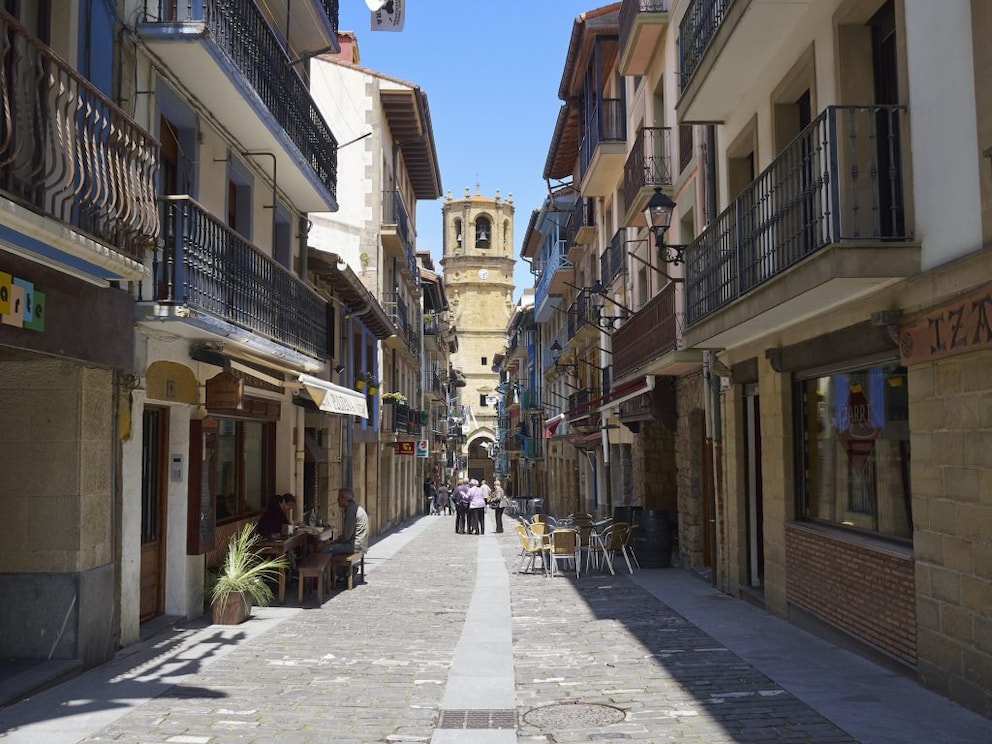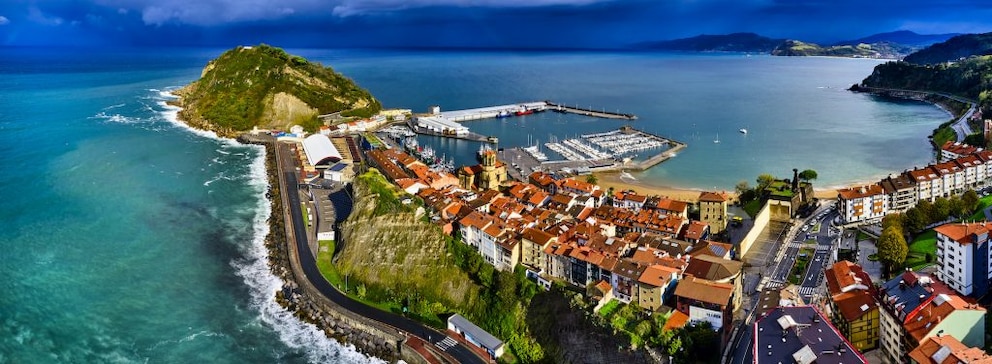June 25, 2025, 3:49 am | Read time: 5 minutes
The Basque town of Getaria is one of Spain’s most beautiful (and still lesser-known) coastal villages. It is the birthplace of Juan Sebastián Elcano, who completed the first circumnavigation of the globe 500 years ago.
Massive rock folds descend steeply to the beach. Above them, meadows shine in vivid green. Sharp-edged rock lamellae extend far into the sea off the Basque coast of Getaria. Earth shifts and water have shaped the bizarre cliff landscape near Zumaia.
The best view of this natural wonder is from the sea. The alternating sequence of marine sediments from clay stones and coarser sandstones, known as flysch, almost seamlessly depicts the Earth’s history over the past 60 million years.
A black-green sediment layer marks the moment when a gigantic asteroid struck the Earth’s mantle in what is now the Gulf of Mexico, covering the entire globe with ash and fire, ultimately leading to the extinction of the dinosaurs.
For Juan Sebastián Elcano, however, the impressive rock formations in the fall of 1522 were a sign of finally being home again. Just a few kilometers further, the seafarer must have spotted the wooded island hill San Antón, towering high above the harbor quay of his hometown Getaria.
In Getaria, the Memory of Elcano Lives on
Elcano (1487-1526) had completed one of the greatest sea adventures in history: the first circumnavigation of the world, which also proved that the Earth is round. His contemporaries celebrated him as a hero. That’s why places and streets in Getaria are still dedicated to him today.
The fishermen’s association was also named after him. His statues stand in several squares of the picturesque fishing village nestled between two beaches. At Malkorbe Beach, you can enjoy a wonderful swim. At Gaztetape Beach, the sea is rougher, attracting surfers. A huge monument on the foundations of an old bastion commemorates Elcano’s historic voyage of discovery.

Magellan as a Myth? “Historical Injustice”
On September 20, 1519, he set out from the southern Spanish Sanlúcar de Barrameda under the leadership of the Portuguese navigator Ferdinand Magellan to seek a western sea route to the Indonesian Spice Islands, the Moluccas. Elcano was the captain of the “Concepción,” one of the five ships of the expedition.
“Today, almost everyone thinks of Magellan when it comes to the first circumnavigation of the Earth. But that is a historical injustice,” says historian Daniel Zulaika, who has written a book about Elcano. “Magellan neither planned to circumnavigate the Earth nor did he ever achieve it.”
However, it was Magellan who led the expedition halfway and became a myth as a slain hero, against whom Elcano could not prevail, says Zulaika. “In fact, it was Elcano under whose command the circumnavigation was completed.”
Of the total 247 men of the expedition, only 18 emaciated figures returned to Spain aboard the “Victoria” on September 6, 1522. Scurvy, storms, mutinies, and battles had claimed most of their lives. Magellan died halfway through the historic circumnavigation on April 27, 1521, in a hail of arrows from Philippine islanders.
Elcano Also Died on an Expedition
After Magellan’s death, Elcano took command of the remaining ships and sailed from the Philippines to the Spice Islands. For the return journey, he chose the route around the Cape of Good Hope at the southern tip of Africa and completed the unplanned circumnavigation after almost three years. Spain’s king awarded him a coat of arms crowned with a globe and the Latin inscription “Primus circum dedisti me” (“You were the first to circumnavigate me.”).
In Getaria’s Gothic church San Salvador, where Elcano was baptized and his father is buried, this inscription is on an old stone slab in memory of the Basque national hero. “Many, therefore, think Elcano is buried here. But that’s not true. He died in 1526 on a second expedition to the Spice Islands from scurvy,” explains historian Zulaika.
Of course, the former whaling village has changed since Elcano’s time. In a major fire in 1597, the seafarer’s birthplace was also destroyed. A sign still marks the exact location.

Fishing Is a Great Tradition in Getaria
Nevertheless, the medieval town center has largely been preserved, assures Zulaika on a city tour. The church, the four street alleys to the harbor, the defense tunnels leading through the city wall to the sea — all of this existed in Elcano’s time.
Getaria was then one of the most important fishing ports in the Bay of Biscay, under royal protection. From Mount San Antón, where wooded hiking trails to the lighthouse today repeatedly offer views of the sea and Getaria, one could spot not only whales but also enemy ships from nearby France.
Even today, Getaria has a large fishing fleet. In the picturesque alleys of the old town, the smell of grilled fish is everywhere. In front of almost every restaurant, sea bream, rays, bass, and other freshly caught delicacies sizzle over an open charcoal fire. Inside, the counters are full of pintxos, the Basque gourmet answer to Spanish tapas.
Gourmet Preserves and Basque White Wine
Gourmet companies offer fish products, seafood, and anchovies in cans. The fishing village has several small canning factories. At the gourmet entrepreneur Maisor in the harbor, you can watch women cleaning and packing sardines and tuna by hand. During the tasting, Txakoli is, of course, drunk. The young Basque white wine is mainly produced by winemakers around Getaria. The town is surrounded by Txakoli vineyards. Up to 30 businesses produce the sparkling, fruity coastal wine here. “Besides the humid, rainy climate, it is mainly the salty sea air of the nearby Atlantic that gives our Txakolis their special taste,” says Txakoli winemaker Joseba Lazkano. Did Elcano already drink the white wine? Quite possible. The first records of cultivation go back much further.
As a change from seafaring tradition, wine, and fishing, a visit to the Cristobal Balenciaga Museum is recommended. The museum is dedicated to the famous fashion designer who was born in Getaria.

This Greek Island Is as Beautiful as Santorini, but Cheaper

Ponza–This Italian Island Is Still a Hidden Gem!

The best route for a road trip along the French Atlantic coast
Traveling to Getaria
Fly to Bilbao or San Sebastián. From there, Getaria can be easily reached by public buses.


